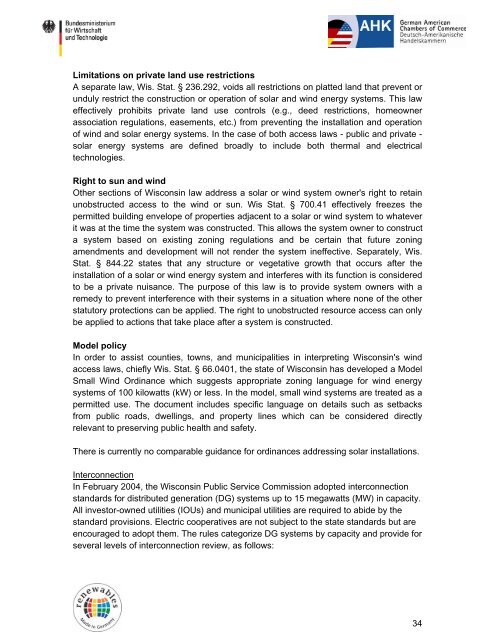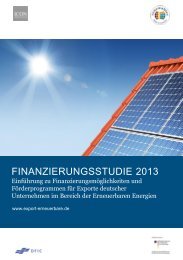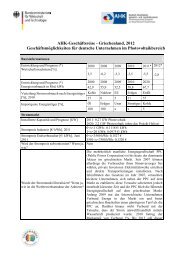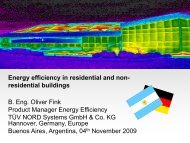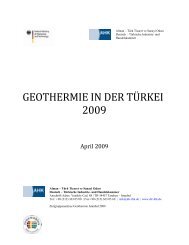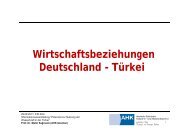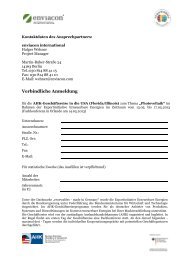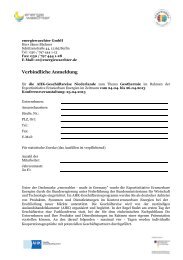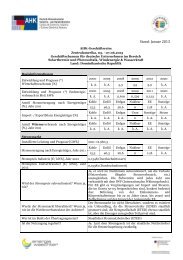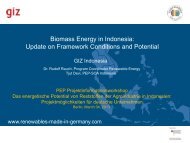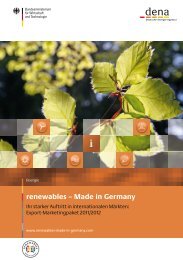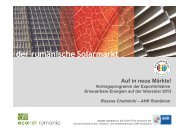PDF: 1,1 MB - Exportinitiative Erneuerbare Energien
PDF: 1,1 MB - Exportinitiative Erneuerbare Energien
PDF: 1,1 MB - Exportinitiative Erneuerbare Energien
- No tags were found...
You also want an ePaper? Increase the reach of your titles
YUMPU automatically turns print PDFs into web optimized ePapers that Google loves.
Limitations on private land use restrictions<br />
A separate law, Wis. Stat. § 236.292, voids all restrictions on platted land that prevent or<br />
unduly restrict the construction or operation of solar and wind energy systems. This law<br />
effectively prohibits private land use controls (e.g., deed restrictions, homeowner<br />
association regulations, easements, etc.) from preventing the installation and operation<br />
of wind and solar energy systems. In the case of both access laws - public and private -<br />
solar energy systems are defined broadly to include both thermal and electrical<br />
technologies.<br />
Right to sun and wind<br />
Other sections of Wisconsin law address a solar or wind system owner's right to retain<br />
unobstructed access to the wind or sun. Wis Stat. § 700.41 effectively freezes the<br />
permitted building envelope of properties adjacent to a solar or wind system to whatever<br />
it was at the time the system was constructed. This allows the system owner to construct<br />
a system based on existing zoning regulations and be certain that future zoning<br />
amendments and development will not render the system ineffective. Separately, Wis.<br />
Stat. § 844.22 states that any structure or vegetative growth that occurs after the<br />
installation of a solar or wind energy system and interferes with its function is considered<br />
to be a private nuisance. The purpose of this law is to provide system owners with a<br />
remedy to prevent interference with their systems in a situation where none of the other<br />
statutory protections can be applied. The right to unobstructed resource access can only<br />
be applied to actions that take place after a system is constructed.<br />
Model policy<br />
In order to assist counties, towns, and municipalities in interpreting Wisconsin's wind<br />
access laws, chiefly Wis. Stat. § 66.0401, the state of Wisconsin has developed a Model<br />
Small Wind Ordinance which suggests appropriate zoning language for wind energy<br />
systems of 100 kilowatts (kW) or less. In the model, small wind systems are treated as a<br />
permitted use. The document includes specific language on details such as setbacks<br />
from public roads, dwellings, and property lines which can be considered directly<br />
relevant to preserving public health and safety.<br />
There is currently no comparable guidance for ordinances addressing solar installations.<br />
Interconnection<br />
In February 2004, the Wisconsin Public Service Commission adopted interconnection<br />
standards for distributed generation (DG) systems up to 15 megawatts (MW) in capacity.<br />
All investor-owned utilities (IOUs) and municipal utilities are required to abide by the<br />
standard provisions. Electric cooperatives are not subject to the state standards but are<br />
encouraged to adopt them. The rules categorize DG systems by capacity and provide for<br />
several levels of interconnection review, as follows:<br />
34


